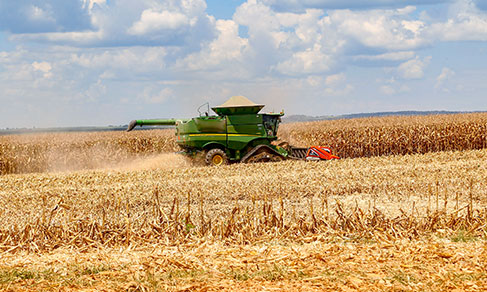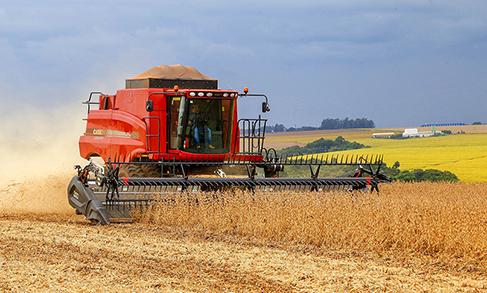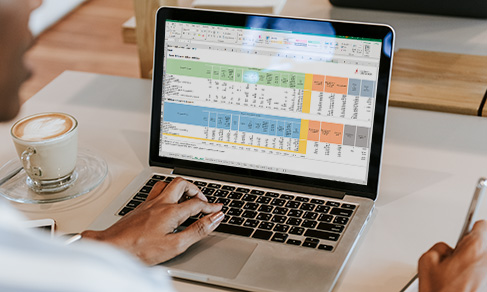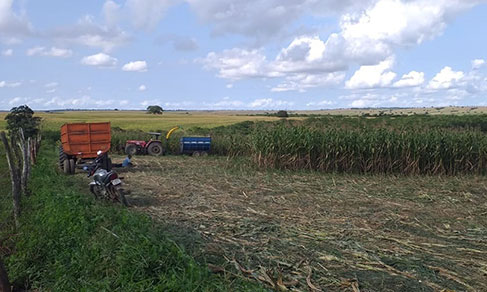Nossos serviços estão apresentando instabilidade no momento. Algumas informações podem não estar disponíveis.
SCR - System of Regional Accounts
 Experimental Statistics
Experimental Statistics
About - 2018 Tables of Resources and Uses by Federation Unit: Matrices of production account
The System of National Accounts - SNA is based on the identity between supply and demand of goods and services. On the demand side, all goods and services produced in an economy are consumed (either as intermediate consumption in the production process or as final consumption by households and governments), stocked, destined to investment or exported. Part of the demand is also provided by imported goods and services. Therefore, on the supply side, all goods and services used in an economy are either produced in that economy or imported.
The Tables of Resources and Uses (TRUs) show the relations between supply and demand, detailing the flows by activity and product, as well as the generation of value added in each economic activity. The IBGE publishes these matrices, in the national scope, since the 1990s. The Tables of Resources and Uses by Federation Unit improve the detailing of such information for the 27 Brazilian Federation Units.
The experimental statistics now released show the production matrix and the intermediate consumption matrix for 12 activities and 12 products - the most aggregate classification of the Brazilian National Accounts - and comprise the first step in the building of complete regional TRUs. The complete TRUs will include the remaining supply (imports) and demand (final consumption, investment, stock change and exports), thus providing a general overview of the economy in each Brazilian Federation Unit.
These experimental statistic were developed from the data sources usually used in the compilation of the Brazilian National and Regional Accounts, complemented by records of fiscal documents received through a technical cooperation agreement with the Brazilian Special Secretartiat of Federal Revenue. One of the objectives of this agreement is the use of fiscal records to provide regionalized information about the economic activity, preserving the statistical confidentiality of the information provided by tax payers.
 Experimental Statistics
Experimental Statistics
Concepts and methods - 2018 Tables of Resources and Uses by Federation Unit: Matrices of production account
As informações a seguir descrevem os metadados estatísticos, que são o conjunto de conceitos, métodos e aspectos relacionados às estatísticas, e são informações necessárias para compreender as características e a qualidade das estatísticas e interpretá-las corretamente.
Informações Gerais
Objetivo
Calcular o PIB e o Valor Agregado para as 18 Atividades Econômicas a Preços Correntes e a Preços Constantes do Ano Anterior. De acordo com o SNA 2008 e a ISIC REV. 4.Tipo de operação estatística
Sistema de contas nacionaisTipo de dados
Outro tipo de dadosPeriodicidade de divulgação
AnualMetodologia
A metodologia adotada no Sistema de Contas Regionais do Brasil é uniforme por Unidade da Federação e integrada à utilizada pelo Sistema de Contas Nacionais, também do IBGE.
O Sistema de Contas Regionais referência 2010, em virtude de suas particularidade, estima o Produto Interno Bruto – PIB pelas óticas da produção e da renda, apresentando informações referentes ao processo de produto e geração da renda regionalmente. A ótica da produção mostra o resultado do processo de produção, o valor de produção (VP), menos o consumo intermediário (CI), de cujo saldo, valor adicionado bruto (VAB) por atividade econômica, somado aos impostos, líquidos de subsídios, sobre produtos resultado o PIB. Pela ótica da renda, o PIB é igual à soma das remunerações dos fatores de produção, isto é, corresponde ao somatório das remunerações dos empregados, mais o rendimento misto bruto, mais o excedente operacional bruto, mais o total dos impostos, líquidos de subsídios, sobre a produção e importação.
A série do Sistema de Contas Regionais referência 2010, incorpora os resultados do Censo Agropecuário 2006, as pesquisas anuais, por empresas, nas áreas de Indústria, Construção, Comércio e Serviços, e de pesquisas domiciliares, tais como a Pesquisa Nacional por Amostra de Domicílios - PNAD e a Pesquisa de Orçamentos Familiares - POF2008-2009, realizadas pelo IBGE; utiliza dados anuais de instituições externas, como a Declaração de Informações Econômico-fiscais da Pessoa Jurídica - DIPJ, obtidos pela Secretaria da Receita Federal; e adota uma classificação de atividades e produtos compatível com a Classificação Nacional de Atividades Econômicas - CNAE 2.0.
A metodologia de construção das Contas Regionais do Brasil, referência 2010, segue as recomendações e modificações do manual internacional de Contas Nacionais das Nações Unidas, System of national accounts 2008, SNA 2008, em complementação à versão anterior de 1993. Apresenta atualizações de conceitos, métodos e procedimentos utilizados na elaboração desta série, permitindo ao usuário maior compreensão no trato das atuais estatísticas de contabilidade regional.
Técnica de coleta:
Não se aplicaTemas
Temas e subtemas
Contas Nacionais, Estatísticas macroeconômicasPrincipais variáveis
PIBValor Adicionado por Atividade
Unidades de informação
Unidade de investigação
Pessoa, Domicílio, Não se aplica, Entidade sem fins lucrativos, Órgão da Administração Pública, Unidade da Federação, Município, Produto, Unidade local, Estabelecimento, Empresa, Unidade doméstica, FamíliaUnidade de análise
Entidade sem fins lucrativos, Órgão da Administração Pública, Unidade da Federação, Município, Produto, Estabelecimento, Empresa, Unidade doméstica, Família, Domicílio, Pessoa, Unidade localUnidade informante
Não se aplica.Períodos de referência
Disseminação
Formas de disseminação
Publicação Digital (online)Nível de desagregação geográfica
Unidade da FederaçãoNível de divulgação
Brasil por Unidades da FederaçãoHistórico
A legislação referente aos Fundos de Participação de Estados e Municípios data de 25 de outubro de 1966, quando a Lei nº 5.172 estabeleceu nos artigos 86 e 88 os critérios de distribuição do Fundo de Participação dos Estados e do Distrito Federal. Para efeito deste cálculo, deveriam ser levadas em consideração a superfície territorial, a população estimada de cada estado e município e a renda per capita dos estados.
Coube, inicialmente, à Fundação Getulio Vargas a responsabilidade pela estimativa da renda por estado e, ao IBGE, a estimativa da população. Quando o IBGE assumiu a responsabilidade pela elaboração das Contas Nacionais do Brasil em 1986, passou a ter a atribuição de calcular a renda per capita dos estados.
A primeira série do Sistema de Contas Regionais estimada pelo IBGE foi divulgada em 1999, tendo o ano de 1985 como referência. No ano de 2007 o Sistema de Contas Regionais foi revisado e passou a ter o ano de 2002 como referência. Em 2015, nova revisão da série regional foi realizada tendo como referência o ano de 2010.
A atualização de uma série de contas regionais é normalmente compreendida como a atualização dos pesos das atividades econômicas adotadas no cálculo do Produto Interno Bruto e de seus componentes a preços constantes de um determinado ano. A revisão do ano de referência também é o momento em que novas fontes de dados, classificações e resultados de pesquisas realizadas visando o estabelecimento de marcos estruturais são incorporados.
Saiba mais
https://metadados.ibge.gov.br/consulta/estatisticos/operacoes-estatisticas/SRDescription
The System of Regional Accounts – SCR provides estimates of the Gross Domestic Product – GDP of each Federation Unit, from the perspective of production and income, that are consistent and comparable to each other, and compatible with the results of the System of National Accounts – SCN.
The work program for the creation of an Account System by Federation Unit, developed by the IBGE in partnership with State Statistical Bodies, State Government Departments and the Superintendence of the Manaus Free Trade Zone – SUFRAMA, aims at meeting the demand for regionalized information. This project started in 1996 and was consolidated in 1999, with the results released for the period from 1985 to 1997, with 1985 – last year of the Economic Censuses – being the initial reference year of the series. In 2007, the first version of the regional series was revised, with 2002 as the reference year. Due to the Federation Units particularities, it was decided that the System of Regional Accounts, in its first phase, would be restricted to the design of the production account of the main economic activities, in accordance with the SCN methodology, presenting information regarding the regional income creation process, whose summary value is expressed by the GDP. In this way, the GDP by Federation Unit was estimated, initially, only from the perspective of production. In 2015, a new revision of the regional series was done, with its methodology and database compatible with the System of National Accounts – reference 2010, that is, the System of Regional Accounts – SCR is in accordance with the international recommendations expressed in the manual System of National Accounts 2008 - SNA 2008, and its results are presented according to the products and activities classification integrated with the National Classification of Economic Activities – CNAE 2.0. In this review, the regional series also started to include the income perspective in the GDP calculation.
The SCR provides GDP data from the perspective of production (series retropolated until 2002) and income for the 2010-2015 series. The production perspective shows the result of the production process, less the intermediate consumption, whose balance, gross value added by economic activity, plus taxes, net of subsidies, on products results in the GDP. On the other hand, the income perspective shows the GDP as a result of the sum of the remuneration of production factors, that is, compensation of the employed persons, plus the gross mixed income, plus gross operating surplus, plus the total taxes, net of subsidies, on the production and imports.
It is an annual survey, and its geographic coverage is national, with results released for Brazil, Major Regions and Federation Units.
Technical Information
Technical and methodological notes
Regional Accounts - Reference 2010
System of National Accounts (SNA) - reference 2010
News and Releases
GDP grows in all the 27 states in Brazil in 2023
Gross Domestic Product (GDP) grew in all the 27 Federation Units in Brazil in 2023 from the previous...
14/11/2025
In 2022, GDP grows in 24 Federation Units
In 2022, the Brazilian Gross Domestic Product (GDP) hit 10.1 trillion, with a growth of 3.0% in volume...
14/11/2024
In 2021, GDP grows in all 27 Federation Units
After dropping in 2020 mainly due to the effects of the COVID-19 pandemic, The Brazilian Gross Domestic...
17/11/2023
In 2020, first year of the pandemic, GDP falls in 24 of the 27 Federation Units
In 2020, the Gross Domestic Product (GDP) of Brazil reached R$ 7.6 trillion, with a decrease of 3.3%...
16/11/2022
Cooperation between IBGE and Federal Revenue details supply and demand in Federation Units
The IBGE releases today (3), the Tables of Resources and Uses by Federation Units (2018). The tables...
03/08/2022
Regional Accounts: GDP rose in 22 states in 2019
In 2019, the Brazilian Gross Domestic Product (GDP) advanced 1.2%, with growth in 22 out of 27 Federation...
12/11/2021
GDP grows above national average in 13 Federation Units in 2019
Twelve states and the Federal Districy rcorded an increase in Gross Domestic Product (GDP) in 2019, above...
12/11/2021
Regional Accounts: only Sergipe records a drop in GDP in 2018
The Brazilian Gross Domestic Product - GDP grew 1.8% between 2017 and 2018. Among the 27 Federation Units,...
13/11/2020
Fifteen states have GDP above the national average in 2018; only Sergipe records a drop
Fifteen states registered growth of volume in the Gross Domestic Product – GDP 2018 above the national...
13/11/2020
GDP falls in three states in 2017; Rio de Janeiro has the sharpest drop
Rio de Janeiro, Sergipe and Paraíba were the only states with a fall in Gross Domestic Product (GDP)...
14/11/2019
Errata
Replacement of files of Supply and Use Tables by Federation Unit 2018
Published date: 03/08/2022
Description:
Error noticed in the Supply and Use Tables by Federation Unit 2018. The files available on the IBGE Portal were not in their final version and should be replaced.Actions: The files were replaced and an updating note was included on the results page of the survey on the IBGE Portal.

Estas estatísticas são classificadas como experimentais e devem ser usadas com cautela, pois são estatísticas novas que ainda estão em fase de teste e sob avaliação. Elas são desenvolvidas e publicadas visando envolver os usuários e partes interessadas para avaliação de sua relevância e qualidade. Caso deseje deixar uma crítica ou sugestão, clique aqui para deixar sua opinião.













